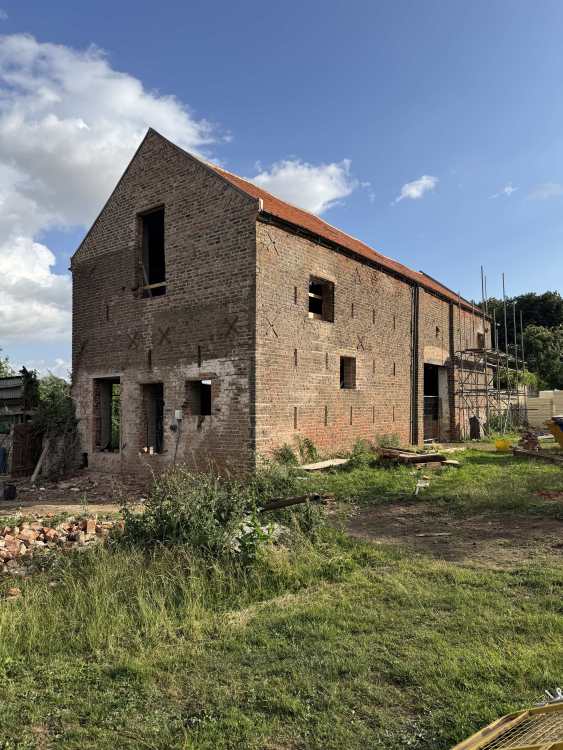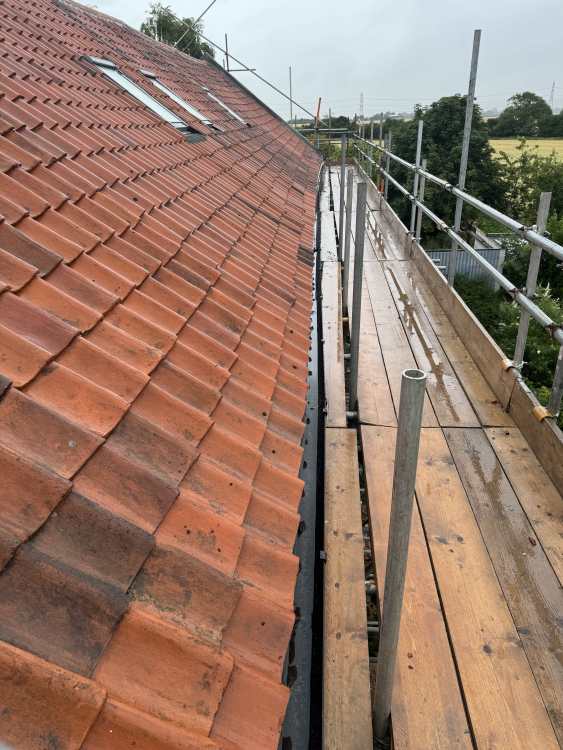
BadgerBodger
Members-
Posts
165 -
Joined
-
Last visited
-
Days Won
1
Everything posted by BadgerBodger
-
Graf waste water treatment plant, any thoughts?
BadgerBodger replied to joe90's topic in General Self Build & DIY Discussion
Just a quick FYI on the pump being in the tank for Marsh. Yes it is normally BUT if you choose the pumped outfall it isn’t and can’t be (according to Marsh) I bought mine through my merchant choosing both options pumped and inbuilt but it came pumped only and only when I enquired did I find out it’s one or the other. -
Sore feet - better boots!
BadgerBodger replied to Lincolnshire Ian's topic in General Self Build & DIY Discussion
Haix Trekker Pro 2.0 - I have a lot of boots and these stand out as the best. Two colleagues had their first pairs for 3 years 5 days a week. Soles wore out. I’m on year two and no signs of stopping yet. They’re a bit stiff and clunky but with the ankle height your sure footed alright. I took them home for my build and got some Haix AirPower XR3 for work and they’re lighter and more flexible. Feel like they’ll last just as long. not cheap though -
Sewage Treatment Plant self install
BadgerBodger replied to MortarThePoint's topic in Waste & Sewerage
@saveasteading the bigger hole point is a good one, I spent another couple of hundred on the gravel backfill because of the over dig. Only by 250mm all sides due to exposing for archaeologist investigation and relief drawings but nonetheless… -
Sewage Treatment Plant self install
BadgerBodger replied to MortarThePoint's topic in Waste & Sewerage
Nice. I like that so many people see the same opportunities. STP install is very easy. Same for drainage field. Wouldn’t like to do it at this time of year though. Hate claggy boots. Here’s mine with drainage field. Marsh ensign pumped so I didn’t have such a deep drainage field. 3 days on the hottest day of the year. digger, dumper, driver, plant, materials and yours truly just under 5700 not much better than muddy boots really! -
Flood risk - refining risk level; mitigations
BadgerBodger replied to Drellingore's topic in Surveyors & Architects
Our area has a flood risk assessment with a predefined FFL which all new properties are required to comply with. I’m not sure we could have argued otherwise if we liked! We just accepted it for what it was and our internal FFL is 450mm above the external level. Is this something that is available/defined for your area? -
Don’t think it’s much easier if you’re younger!!! I’m not yet 40 and I’m still feeling the pain!! If it’s not your day job any task can really put a strain on you as it uses different muscle groups. I’m pretty fit, one of those swim, bike, run guys, but last week, steel fixing, laying drainage, shoveling hardcore, general carting, power tools and hammering roof nails really (expletive deleted)ed me up. Only just got over it today, ready to start the cycle again!!! I do have a “desk job” though…
-
Work to a Perlin roof without notifying us
BadgerBodger replied to Andy62's topic in Roofing, Tiling & Slating
All new slate for that size. I’d say the price was about right if not good values. if you had a full reroof it should have had BR app anyway? nothing that can’t be resolved with either, retrospective regularisation or an indemnity policy… -
Work to a Perlin roof without notifying us
BadgerBodger replied to Andy62's topic in Roofing, Tiling & Slating
As @Nickfromwales is saying. It looks like they’ve just reinforced the existing structure. some of this might be been due to a need due to rot, or the builders opinion that what was there was inadequate or even just for ease and safety of battening. the original rafter spacing appear irregular, you don’t often see them not meeting at the spar ends which would possibly explain the reinforced ridge which he would then probably have nailed into. then the original rag gets are also not parallel and/or straight. This can present an issue for counter battening (if done) and lathing. it just takes a bit more time really but if the spacing is excessive walking the lathe afterward may in his view have been unsafe (too much deflection. seeing the type of roof timbers originally used this looks like a really old house? It’s quite typical to see a hodge podge of solutions up there are everyone has their own take. unless you have a defect now because of it, I likely wouldn’t be worried. surprising he didn’t mention it though. -
Ingress of Water into Inspection Chambers
BadgerBodger replied to Arrenite's topic in Waste & Sewerage
Typically minimum 200mm concrete, wet cast with jacket. Or mass fill the hole. Well pokered. I suppose on a smaller ring you could use something like peckafil or even heavy duty correx. Should be effective enough. If it were a concrete ring with torching that were leaking this would reduce it to damp patches in most scenarios. -
@Kelvin can you use it WITH hue? My vision was to essentially install the sonoff relay so the bulb was „always on” bit disregard is own „smart” functionality . I think this was the problem @Benpointer was trying to resolve too?
-
Is the Sonoff mini something that works? I haven’t got one yet but it looks like the route I will take.
-
Paslode 360Xi Framing Nailer Vs Paslode IM350+
BadgerBodger replied to flanagaj's topic in Tools & Equipment
Can confirm 360 xi seems to do the job. 63mm ringshanks go with ease. yet to try 90mm -
2nd for Lewis. Allthough I got the 3t industrial double. 8.8m working height. it’s solid, even at height if erected correctly. For me, same as Nick, this was an investment for ongoing maintenance etc. So bought new.
-
Interesting. Yes I had forgotten about this metric. I’ll ask my SE. It is around 90m2 (6x10) 100-125 thick (varies for to existing substrate and is easier to resolve with additional concrete) and is loaded with perimeter stud walls to FF and internal furniture including kitchen etc. XPS is even more expensive though no? At which point I might as well use PIR and build levels with stone?
-
Hey, I’m looking to use EPS insulation (around 300mm) below by ground bearing slab within the existing structure. Having used the a Treanor Pujol insulated block and beam system I noticed that the “blocks” were EPS 70 but the overlay was EPS 100. It got me thinking, should I be using EPS 70 or 100 below by slab? There is a not insignificant cost difference (the lower density being cheaper) and my only reference point in having used EPS under a slab was a crew yard which was EPS 200 and when I used it as a void former/filler under a disabled access ramp which was EPS 100. For reference the insulation will be laid onto “blinding” (old block paving) or compacted sand in two layers with the. DPM sandwiched between the layers to allow me to tack the UFH pipe work to the upper layer before mesh and pour. Badger
-
Aluminium Gutters / Soffits - Who to use?
BadgerBodger replied to boxrick's topic in Roofing, Tiling & Slating
Quality was fine barring one section of gutter which was a different gauge but marked as the same (maybe old/new stock). Sent off to almumasc for takeoff and did my own based on install guide. We came out roughly the same. I dropped a few things, added others. colour is black. -
Aluminium Gutters / Soffits - Who to use?
BadgerBodger replied to boxrick's topic in Roofing, Tiling & Slating
These are the best I have to hand. The Dow pipes weren’t installed as I’d just struck the scaffold. Laid to a nominal fall (1:100) Don’t mind the wonky roof. We straightened it up as much as we could but it runs out by 150+ mm. The photo was just after a heavy summer downpour which is why the gutter was full. -
Encapsulation is an acceptable strategy so long as there is an adequate record maintained of its location, encapsulation, asbestos type etc. This record would then need disclosing to any future buyers etc. Read up on it, and make your own discussion. This came up a couple of months ago and the general consensus was that work falling outside NNLW was pretty affordable and discharging the ongoing risk/responsibility was worth the squeeze. Just one note, if the asbestos tiles were bonded with bitumen there is a good chance that if tested, that bitumen would test positive for chrysotile too. It was also bound within the bitumen around that time too.
-
Power floated slab. Now rethinking micro-cement
BadgerBodger replied to flanagaj's topic in General Flooring
Depends on the size of the crack and potentially, what its cause is. When did it crack? During curing? After? What it when it was loaded. When did you load it after pouring? What was loaded? What were the weather conditions when you poured… yadayadayada the list goes on but each cause may require a different action for “satisfactory” rectification. Different structures actually have different permissible crack widths, it’s expected to some extent and designing out cracking can result in some hefty tonnages of steel (structure dependent). The problem is, in my experience, most repairs for cracks are fairly destructive involving injection, raking out and in some cases simply recasting. If they really are minor, you already have a decorative finish and it’s not a water retaining structure, I’d leave it. . -
Aluminium Gutters / Soffits - Who to use?
BadgerBodger replied to boxrick's topic in Roofing, Tiling & Slating
I just got alumasc heritage 125 wide (not deep) about 60m gutter and 30m downpipe -6200 plus and other bits a d bobs which cost about-30 Through local BM better rate than online.







